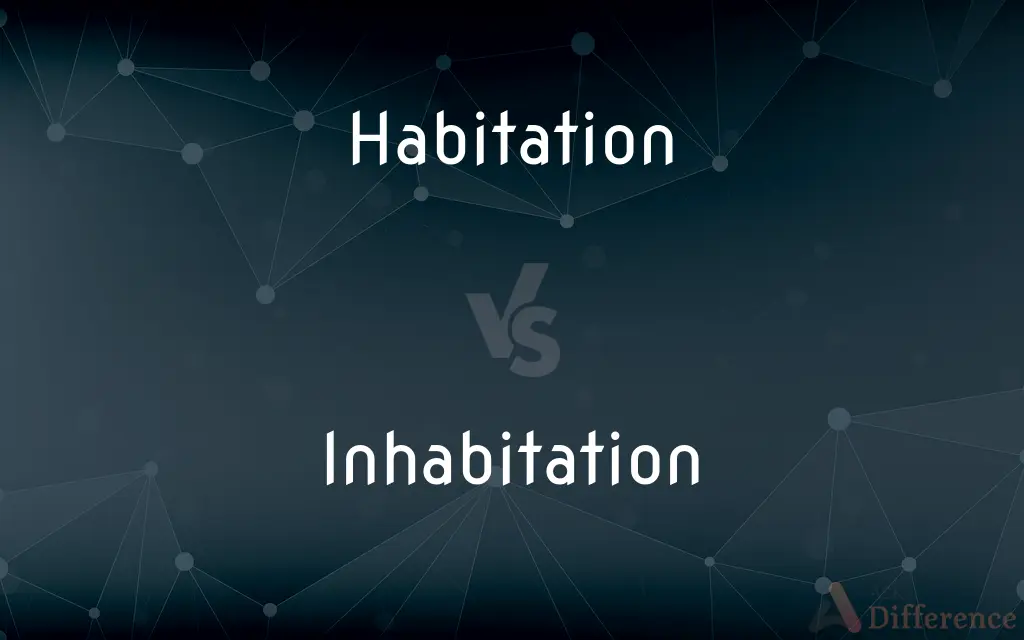Habitation vs. Inhabitation — What's the Difference?
By Tayyaba Rehman & Maham Liaqat — Updated on April 4, 2024
Habitation refers to the act of living in a place or the state of being inhabited, focusing on the place itself, while inhabitation emphasizes the presence and living of people or creatures within that place.

Difference Between Habitation and Inhabitation
Table of Contents
ADVERTISEMENT
Key Differences
Habitation is the condition or act of living in a particular place, highlighting the suitability or adaptation of a space for living. It can refer to both human residences and animal dwellings, underscoring the broader concept of dwelling places. On the other hand, inhabitation specifically denotes the act of dwelling within a place, emphasizing the presence and actions of the inhabitants. It focuses more on the act of living or existing in a space rather than the space itself.
While habitation often implies a sense of permanence or stability, suggesting that a place is fit for living over an extended period, inhabitation conveys the act of occupying or living in a place, regardless of the duration. This distinction underscores the difference between the suitability of a place for living (habitation) and the act of living itself (inhabitation).
In the context of human settlement, habitation can also refer to the development and maintenance of living spaces, including the construction of homes and communities. In contrast, inhabitation is more concerned with the day-to-day activities and presence of people within these spaces, highlighting the dynamic aspects of living in a community or environment.
Habitation often includes considerations of infrastructure and facilities that make a place livable, such as water supply, shelter, and safety. Whereas, inhabitation focuses more on the social and personal aspects of living in a place, such as community engagement and personal routines.
In environmental and ecological discussions, habitation may refer to the adaptation of species to specific habitats, highlighting ecological relationships and sustainability. Inhabitation, however, might emphasize the role of individual species or groups in occupying and interacting within their habitats, pointing to their behaviors and survival strategies within an ecosystem.
ADVERTISEMENT
Comparison Chart
Focus
The place being suitable for living
The act of living by people or creatures
Implication of Time
Often implies a sense of permanence or stability
Can imply temporary or permanent occupation
Context
Can refer to human residences, animal dwellings, and environmental adaptation
Focuses on the presence and activities of inhabitants
Considerations
Infrastructure, facilities, sustainability
Social interactions, personal routines
Ecological Aspect
Adaptation of species to habitats, ecological sustainability
Behaviors and survival strategies of species within their habitats
Compare with Definitions
Habitation
A place suitable for living.
The cabin in the woods offered a quiet habitation away from the city.
Inhabitation
Occupation by residents.
The city is known for its dense inhabitation.
Habitation
The act of residing in a specific location.
Ancient ruins show signs of early human habitation.
Inhabitation
Living or existence in a habitat.
The inhabitation of these lands by early settlers shaped the region’s history.
Habitation
A dwelling place or home.
The new apartment complex provides habitation for over a hundred families.
Inhabitation
Dwelling within a particular space.
The cave’s inhabitation by bats makes it an important study site.
Habitation
Adaptation to a living environment.
Desert plants show remarkable habitation to arid conditions.
Inhabitation
The act of living in a place.
The inhabitation of the new building began last spring.
Habitation
The condition of being inhabited.
The island's habitation by rare species makes it ecologically significant.
Inhabitation
The presence of life in an area.
Coral reefs are bustling with inhabitation.
Habitation
The act of inhabiting or the state of being inhabited.
Inhabitation
To live or reside in
Dinosaurs inhabited the earth millions of years ago.
Habitation
A natural environment or locality.
Inhabitation
To be present in; fill
Old childhood memories inhabit the attic.
Habitation
A residence.
Inhabitation
To dwell.
Habitation
(uncountable) The act of inhabiting; state of inhabiting or dwelling, or of being inhabited; occupancy.
Inhabitation
The act of inhabiting, or the state of being inhabited; indwelling.
Habitation
(countable) A place of abode; settled dwelling; residence; house.
Inhabitation
Abode; place of dwelling; residence.
Habitation
A group, lodge, or company, as of the Primrose League.
Inhabitation
Population; inhabitants.
Habitation
(Louisiana French) A farm.
Inhabitation
The act of inhabiting, or the state of being inhabited; indwelling.
The inhabitation of the Holy Ghost.
Habitation
The act of inhabiting; state of inhabiting or dwelling, or of being inhabited; occupancy.
Inhabitation
Abode; place of dwelling; residence.
Habitation
Place of abode; settled dwelling; residence; house.
The Lord . . . blesseth the habitation of the just.
Inhabitation
Population; inhabitants.
The beginning of nations and of the world's inhabitation.
Habitation
The native habitat or home of an animal or plant
Inhabitation
The act of dwelling in or living permanently in a place (said of both animals and men);
He studied the creation and inhabitation and demise of the colony
Habitation
Housing that someone is living in;
He built a modest dwelling near the pond
They raise money to provide homes for the homeless
Habitation
The act of dwelling in or living permanently in a place (said of both animals and men);
He studied the creation and inhabitation and demise of the colony
Common Curiosities
Is habitation only applicable to humans?
No, habitation can refer to any suitable living space, including those for animals and plants.
How does habitation differ from inhabitation?
Habitation emphasizes the place and its suitability for living, whereas inhabitation focuses on the act of living or dwelling within a place.
What are examples of habitation?
Examples include homes, apartments, and any dwelling places that are suitable for living.
What does inhabitation mean?
Inhabitation denotes the act of dwelling or living within a place, focusing on the presence of people or creatures.
Can habitation and inhabitation be used interchangeably?
While related, they are not entirely interchangeable as habitation often refers to the place, and inhabitation to the act of living.
What role does inhabitation play in a community?
Inhabitation plays a key role in shaping the social dynamics and culture of a community.
How do urban planners consider habitation?
Urban planners consider habitation by designing spaces that are livable, sustainable, and conducive to community life.
What is habitation?
Habitation refers to the act or condition of living in a place, highlighting the place's suitability for living.
Does inhabitation imply permanence?
Inhabitation can imply both temporary and permanent living situations, depending on context.
What does inhabitation involve?
Inhabitation involves the daily activities and presence of individuals or communities within a place.
Why is the study of inhabitation important in anthropology?
Studying inhabitation helps anthropologists understand human behavior, cultural practices, and social interactions within specific environments.
What factors affect habitation in an area?
Factors include climate, resources, infrastructure, and ecological balance.
How is habitation important to ecology?
Habitation is crucial for understanding the adaptation of species to their environments and ecological sustainability.
Can a place have habitation without inhabitation?
Technically, a place can be suitable for living (habitation) without currently being lived in (inhabitation).
How does climate change impact habitation and inhabitation?
Climate change can alter the suitability of places for habitation and affect the patterns of inhabitation due to shifts in resources and habitats.
Share Your Discovery

Previous Comparison
Corny vs. Cheesy
Next Comparison
Assist vs. SupportAuthor Spotlight
Written by
Tayyaba RehmanTayyaba Rehman is a distinguished writer, currently serving as a primary contributor to askdifference.com. As a researcher in semantics and etymology, Tayyaba's passion for the complexity of languages and their distinctions has found a perfect home on the platform. Tayyaba delves into the intricacies of language, distinguishing between commonly confused words and phrases, thereby providing clarity for readers worldwide.
Co-written by
Maham Liaqat













































